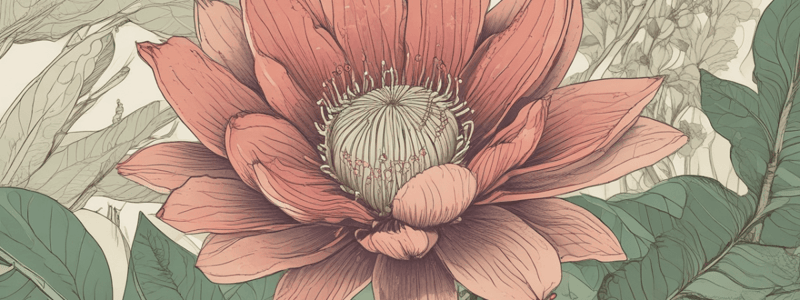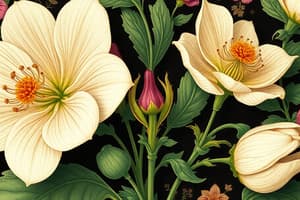Podcast
Questions and Answers
What is the primary purpose of pollination?
What is the primary purpose of pollination?
- To attract pollinators
- To protect the other parts of the flower
- To provide a unique shape and color to the flower
- To produce seeds and offspring for the next generation (correct)
Which part of the flower catches pollen grains?
Which part of the flower catches pollen grains?
- Filament
- Petal
- Stigma (correct)
- Anther
What is the function of the sepal in a flower?
What is the function of the sepal in a flower?
- To protect the other parts of the flower (correct)
- To attract pollinators
- To provide a unique scent to the flower
- To produce seeds
What grows down from the pollen grain to deliver sperm cells to the ovary?
What grows down from the pollen grain to deliver sperm cells to the ovary?
What are some of the vectors that can transfer pollen from one flower to another?
What are some of the vectors that can transfer pollen from one flower to another?
What is the primary purpose of pollinators visiting flowers?
What is the primary purpose of pollinators visiting flowers?
What is the result of successful pollination?
What is the result of successful pollination?
What percentage of plant pollination occurs with the help of animals?
What percentage of plant pollination occurs with the help of animals?
What is a characteristic feature of wind-pollinated flowers?
What is a characteristic feature of wind-pollinated flowers?
Which of the following plants is an example of wind pollination?
Which of the following plants is an example of wind pollination?
What is the primary function of the bright colors and tubular shapes of certain flowers?
What is the primary function of the bright colors and tubular shapes of certain flowers?
What is the main difference between self-pollination and cross-pollination?
What is the main difference between self-pollination and cross-pollination?
What percentage of the human diet comes from plants and plant-derived products that rely on pollinators?
What percentage of the human diet comes from plants and plant-derived products that rely on pollinators?
What is the primary mechanism of pollination in aquatic plants such as waterweeds and pondweeds?
What is the primary mechanism of pollination in aquatic plants such as waterweeds and pondweeds?
What is the advantage of cross-pollination over self-pollination?
What is the advantage of cross-pollination over self-pollination?
Study Notes
What is Pollination?
- Pollination is the transfer of pollen grains from a flower's male anther to the female stigma.
- Its primary purpose is to produce seeds and offspring for the next generation.
Parts of a Flower
- A flower has four main parts: sepal, petal, stamen, and pistil.
- Each part plays a significant role in protecting, attracting pollinators, and reproducing.
- Sepal: protects the other parts of the flower.
- Petal: provides a unique appearance, shape, color, and scent to attract pollinators.
- Stamen: the flower's male reproductive part, consisting of an anther and a filament.
- Pistil: the flower's female reproductive part, composed of the ovary, stigma, and style.
Pollen Transfer
- Pollen is transferred from one flower to another through different vectors, including wind, water, birds, insects, butterflies, bats, and other animals.
- Animals and insects capable of carrying and dispersing pollen grains are collectively called pollinators.
Importance of Pollination
- Essential for fertilization and production of enough seeds for dispersal and propagation.
- Maintains genetic diversity within a population and develops an adequate number of fruits.
- Crucial for ecosystem survival, as most crops and food and plant-based products depend on successful pollination.
- Increases crop and fruit yields and has environmental benefits, such as producing oxygen and purifying water.
Methods of Pollination
- Two methods of pollination: abiotic (wind and water) and biotic (insects and other animals).
- Abiotic pollination: does not require other organisms, used by 20% of plants (e.g., conifers, grasses, cereal crops).
- Biotic pollination: requires the help of insects and other animals, used by 80% of plants (e.g., flowers with colors, shapes, and scents).
Wind Pollination
- Most wind-pollinated flowers appear in spring before or while the leaves are only starting to emerge.
- Flowers are typically small, without petals, odor, or nectar, with large and feathery stigmas.
Animal Pollination
- Plants develop strategies to attract pollinators and effectively disperse their pollen.
- Methods include visual cues, scent, food, mimicry, and entrapment.
Types of Pollination
- Self-pollination: occurs when the plant fertilizes itself, resulting in genetically identical offspring.
- Cross-pollination: requires a pollinator or vector to transfer pollen from one flower to another of the same species.
Pollination Facts
- Between 200,000 to 300,000 invertebrate species are considered pollinators globally.
- Around 2000 vertebrates (e.g., birds, mammals, and reptiles) also help pollinate plants and crops.
- Bees are the primary plant pollinators.
- At least 1500 crop plant species depend on pollinators for reproduction.
- About 30% of the human diet, fibers, edible oils, and medicine come from plants and other plant-derived products, which are only possible due to pollinators and pollination.
Studying That Suits You
Use AI to generate personalized quizzes and flashcards to suit your learning preferences.
Description
Learn about the process of pollination, its importance in seed production, and the different parts of a flower, including their functions.




